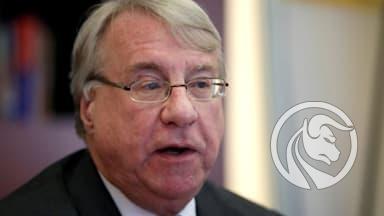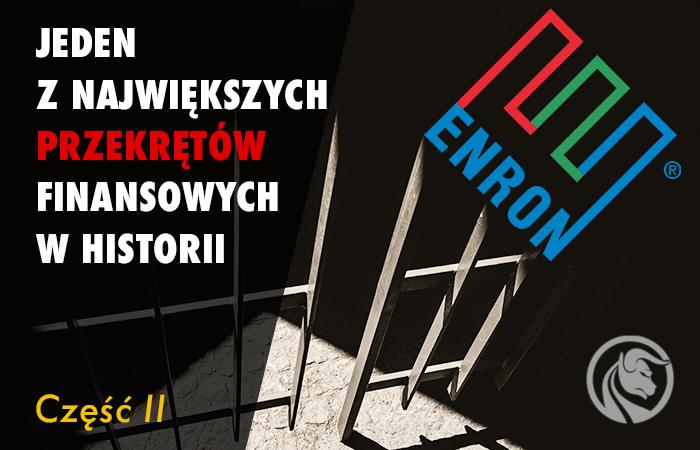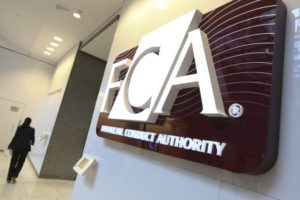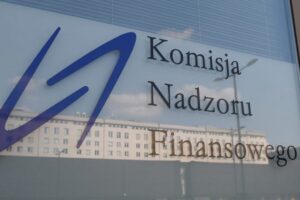Enron's bankruptcy - What led to the collapse of the company? Vol. II
W the first part of Enron's history we introduced you to what special purpose vehicles were and what the company's business model looked like. In the second part, we will focus on the subsequent causes of Enron's bankruptcy. Enron failed for only one reason. There were a number of factors that caused the company to go bankrupt. In the next part of the article, we will present what were the factors that allowed Enron to deceive analysts, investors and regulators.
READ: Enron's bankruptcy - One of the biggest financial scams. Part I
One of the biggest reasons that allowed the financial fraud was the complicated business structure, which made it difficult for investors and analysts to thoroughly analyze the company's operations. In addition, Enron "thrown" some of its losses and liabilities off the balance sheet. This made the company look healthier on paper than it actually was. Enron's bankruptcy is not only operational inefficiency, but also dishonest accounting practices. Andrew Fastow, who was hired by Jeffrey Skilling (Chief Operating Officer at Enron).
Revenue recognition
As we know from the first part, Enron generated revenue from various activities. Both in trading on the wholesale market, investing activities, building and maintaining power plants, and operating on the natural gas transmission market. For this reason, revenue analysis was not as simple as it was back in the 80s.
Because Enron took the risk of buying and selling products, it could report value products sold as revenue (even if they came from speculative transactions) and the cost of purchase as costs of sale. It was a different business model from the so-called "agent", which was to deliver the product to the consumer without taking the risk of buying and selling products. Enron selects type revenue recognition The "merchant model" resulted in a very rapid increase in revenues. Between 1996 and 2000, revenue increased from $13,3 billion to $100,7 billion. It is worth noting that the company operated in an industry that only grew "organically" by a few percent. Such a high revenue growth rate was due to a significant increase in trading activity.
Another problem posed by the analysis of Enron's financial statements were accounting tricks. One of the most common was classifying loans as sales. A great example is the transaction between Enron and Merrill Lynch regarding some Nigerian assets. Just before the end of the quarter, Enron "sold" the assets to an American bank with a buyback guarantee. As at the date of the report, Enron was accounting for revenues and several million dollars in profit from the transaction. In the following quarter, Enron was buying back assets. For fictitious transactions, some senior managers at Merrill Lynch and Enron went to prison.
Mark-to-market accounting
Prior to the advent of the "Skilling era," Enron's accounting was very orderly. In each reporting period, the company recognized revenues and the corresponding costs of gas supplies. Such accounting also applied to long-term contracts, which made it easy to analyze the company's operating profitability. Skilling came up with the idea for Enron to start using mark-to-market accounting.market. The goal was to properly represent the "true economic value" of Enron's contracts. The energy company was the first publicly traded non-financial company to use this accounting model for complex, long-term contracts. This accounting model consisted in estimating the profits from the entire contract and discounting them to the present value (present value of future profits). The problem was that it was difficult to estimate the costs of contracts concluded for, for example, 5 years. This meant that such a model meant that the result was largely dependent on the assumptions made. It could happen that despite reporting profits, Enron did not generate positive cash flow from the contract. Enron had to keep growing to keep up with business growth and meet analysts' expectations. Acquisitions did not have to make economic sense in the long term, but to provide new profits from long-term contracts. Of course, as time passed, such a model became more and more difficult to maintain.
An example contract was the June 2000 deal between Enron and Blockbuster Video. The contract was signed for 20 years and was to introduce services for watching movies and series on demand. After signing the contract, Enron reported a profit of $100 million from the contract. Nevertheless, market analysts questioned the possibility of such a service actually working. After several pilots, Blockbuster terminated the contract with Enron, which forced the company to update the value of the contract.
corporate culture
One of the reasons that led to the Enron scandal was corporate culture. PMS (Performance Management System) was constructed in such a way that it was rewarding "most valuable" employees. Only short-term performance indicators (KPIs) mattered. For this reason, the atmosphere of the rat race prevailed in the company. Nobody thought about the long term, only short-term profit was important, which was rewarded with high bonuses. Therefore, employees wanted to close each transaction as soon as possible, regardless of the long-term effect of the signed contracts. What mattered was to "prove the indicators" and get a bonus. In addition, those transactions that had a direct impact on the nearest financial results were preferred. There was a feedback loop: the more contracts had a short-term, positive effect on profits, the better the financial results. The better the financial results, the higher the share price. This in turn provided more valuable bonuses (paid in shares and options for shares).
There was a frenzy about the stock price in the company. The company's ticker was placed in lobbies, elevators and on company computers. Sam Skilling always asked "what profits do we need to raise the stock price" when setting the budget.
Enron's bankruptcy - timeline
The very process of the collapse of the company is spread over time. This is due to the fact that by throwing some liabilities off the balance sheet and correcting the profit and loss account, Enron had no problems with financing its operations in banks for many years. However, nothing can last forever, eventually problems began to surface.
September 2000 - July 2001: The first cracks appear in Enron's image
In September 2000, a reporter The Wall Street Journal wrote an article on how mark-to-market accounting has become popular in the energy industry. His final conclusion was that investors do not know how the mark-to-market (MTM) model actually affects the company's profits (i.e. what assumptions are behind the MTM valuation). The article piqued the interest of famous short-seller Jim Chanos to delve into Enron's annual report.

Jim Chanos, source: AutoBlog.com
After reading the report, Chanos realized that it was hard to explain why the broadband segment was growing faster than a struggling industry. What's more, he was concerned about the scale of capital expenditures and the large number of shares sold by Enron managers. As a result, Jim Chanos began short selling Enron stock in November 2000.
In March 2001, Bethany McLean of Fortune wrote an article titled "Is Enron Overvalued?" (org. Is Enron Overpriced?). In the article, Bethany questioned how an energy company could trade after 55 times its profits, like most analysts and investors do not know exactly how the company makes money. McLean, persuaded by Chanos, decided to follow the company's annual report. What she was paying attention to was the huge debt that was constantly growing. The journalist tried to contact the management of the company, but they refused to provide detailed explanations. As Fastow himself claimed, Enron has over 1200 trading books for various commodities, and he doesn't want anyone to know what's in those books. The reason was that Enron:
Bethany McLean, source: wikipedia.org
"didn't want to tell anyone where the company made its money".
The company also tried not to share all information with investors. At the results conference of April 17, 2001, she did not provide the balance sheet in her preliminary report (its appearance can be seen, among others, in the pod tym linkiem). To analyst Richard Grubman's remark that Enron is the only company of its size not to include a balance sheet in its preliminary results, Enrin's CEO (Skilling) replied:
"So...uh.... Thank you so much, I appreciate it….. asshole”.
The aforementioned "asshole" has become an inside joke within the corporation ("Ask Why, Asshole"). The event at the results conference aroused indignation and consternation in the investment community. It was also a signal that Skilling was losing his patience, because until now he had reacted coldly or humorously to such remarks.
The company boasted of increasing revenues, but profitability was low. For this reason, in 2001, the company's shares traded 30% lower than the year before. Enron was also not helped by the scandals in which the company was involved. One of them was the project Dabhol Power in India. The reason was allegations of corrupt practices which the company may have been involved. In addition, Enron's reputation was tarnished by the energy crisis in California. As a result, wholesale energy prices between April and December 2000 increased by 800%. Waves of blackouts swept through the state. Enron was blamed for artificially lowering the electricity supply. The crisis in California cost the economy between $40 and $45 billion and ended with the bankruptcy of PG&E (Pacific Gas & Electric).
August 2001 - September 2001: departure of the CEO and start of restructuring
Another red flag was Skilling's resignation as CEO. This took place on August 14, 2001 and was explained by "personal reasons". Shortly before resigning, he sold 450 shares for $000 million. As of August 33, he still owned over one million shares of the company. Kenneth Lay took over from Skilling. Lay's famous August 14, 14 reply to an analyst's question seems grotesque in retrospect:
"NThere are no accounting, trading or reserve issues or any other issues. I think it's fair to say that the company is in the best shape it has ever been."
However, not all Enron employees were of the same opinion. One of the people who warned the CEO about unlawful accounting was Sherron Watkins, who was vice president of Enron. On August 15, 2001, she warned Lay that the firm was at risk of scandal over its accounting practices.
On August 22, 2001, Watkins handed Lay a 6-page memorandum explaining the company's accounting problems. Initially, upper management wanted to fire Watkins for consulting people outside the company, but they decided against it for fear of a lawsuit.
The period of August and early September 2001 is the time when analysts and investors began to be more and more skeptical about the company. Enron shares were also not helped by the generally weak sentiment in the stock market. The attack of September 11, 2001 diverted media attention from the company. Enron decided to use this time to restructure Portland General Electric, Northwest Natural Gas and a 65% stake in the Dabhol project were put up for sale.
October 2001 - one step away from bankruptcy
On October 16, 2001, Enron announced a revision of its financial reports from 1997 to 2000. As a result, net profit fell by $613 million (23% of all profits made at that time), liabilities increased by $628 million (an increase of 6%) and equity by 10% (i.e. $1,2 billion).
On October 22, the SEC announced that it intended to launch an investigation into some of the transactions carried out by Enron. The reason was that some of the transactions with special purpose vehicles involved people from Enron's senior management. The CEO of Enron announced that he intends to fully cooperate with the SEC to clarify all uncertainties related to the transactions. In turn, investors were told that these transactions were related to hedging their market positions.
On October 25, Fastow was fired as CFO because some banks refused to continue working with the company until the company's CFO changed. Enron shares fell to $16,41 after the news, down 50% in just one week. The fall in the share price caused Enron to have problems with its loan collateral. In many cases, the loans were secured by company shares. The decrease in their value forced the company to introduce further securities on the company's assets.

Source: wikipedia.org
Due to the loss of confidence, Enron had trouble rolling over its short-term debt instruments. The reason was the mess in the finance department. Fastow was so absorbed in the work of creating an SPE (i.e. a special purpose vehicle) that he did not develop any tools to help track the maturity of debt and the level of cash held by the company. By late October, Enron was unable to regain liquidity.
October 29, two rating agencies Fitch and Moody's downgraded their ratings. This made the company's situation even worse. A lower rating means less demand for bonds and a drop in the value of shares, which were often collateral for many of the company's loans.
Last Hope - Deal with Dynegy
Enron's bankruptcy seemed only a matter of time. Enron's problems resulted in the fact that people willing to take over the overpriced giant appeared in the area. One of them was a competitor "from behind the border" - Dynegy. The company announced its willingness to acquire the entirety of Enron for $8 billion paid in shares. In addition, the company committed to take on $ 13 billion of official debt and all hidden debt, which Dynegy estimated at $ 10 billion. Enron's bankruptcy was looming.
The willingness to carry out the transaction was announced on November 8, 2001. In addition, Dynegy agreed to invest $1,5 billion to keep the dying Enron alive. Fusion didn't mind another corpse in the closet either. A day later, another correction of reports for the years 1997 - 2000 was announced. According to them, the company's revenues were reduced by $ 591 million, which resulted in the "erasing" of the profit for the entire 1997 year.
The situation was exacerbated by credit agencies, which downgraded credit ratings to near-junk status. Despite this, Dynegy and Enron were still interested in the transaction. However, Enron's contractors were not so optimistic. Fearing more dead bodies in the closet, they decided to end their business relationship with Enron. The mood inside the company was also a problem. Many employees in their retirement accounts had purchased only Enron shares. Many of them have lost most of their pension capital.

Source: wikipedia.org
Enron desperately needed capital to pay off its debts. They were huge, by the end of 2002 Enron had to roll over bonds worth 8 billion dollars. To this end, he announced a plan to sell the problematic assets for several billion dollars. Cash was running out faster than Enron and Dynegy management had anticipated. Enron announced that the $5 billion they had in their bank accounts was depleted in just 50 days. This worried analysts and Dynegy itself, which did not control what Enron spent its funds on. On November 22, there were rumors of a renegotiation of the contract. Dynegy was to pay $4 billion in stock.
However, on November 28, the worst-case scenario came true - two rating agencies downgraded their ratings to junk level. This meant Dynegy could not merge with Enron. As a result, the future of the company was doomed - bankruptcy awaited it. Enron's bankruptcy was not only a problem for shareholders but also for employees, banks and derivatives contractors. Initially, the potential bankruptcy costs were estimated at $18,7 billion. After 24 hours, the debt was estimated at $23 billion. From the banking sector, Citigroup and JP Morgan Chase were to suffer the greatest losses. On November 30, Enron Europe declared bankruptcy. On December 1, shareholders voted to protect the company from creditors (Chapter 11). It was the largest bankruptcy in US history (surpassing PennCentral in 1970).
Enron's bankruptcy - consequences
The bankruptcy of Enron caused great turbulence in the financial market. A failed company with a total asset value of over $63 billion. 4000 employees immediately lost their jobs, and many of them lost 97,5% of their retirement savings. The company's pension fund lost about $2 billion. In 2004, the US Bankruptcy Court agreed to a plan to reorganize the company's operations to pay its creditors. In the years 2004 - 2011 Enron Creditors Recovery Corp. cashed in and paid $21,7 billion to creditors.
Kenneth Lay, the CEO of Enron, has been accused of financial and banking fraud. However, he did not live to see the sentence - he died as a result of a heart attack. Jeffrey Skilling, on the other hand, was sentenced to 24 years in prison for fraud, insider trading and document forgery. Jeffrey spent only 12 years in prison. He got out of prison in 2019.
Justice also reached the auditor. He was accused of deliberately hiding the truth, which in turn ruined the company's reputation. Arthur Andersen was "wiped off the market". It was a huge price to pay for audit services, which in 2000 alone amounted to $52 million ($1 million per month).
Enron's bankruptcy also had a positive effect. It forced changes in the law. In 2002, the SOX Act was introduced at the federal level (Sarbanes-Oxley Act). The law tightened the penalties for counterfeiting, falsifying and destroying financial documents. It also raised liability (criminal and civil) for audit firms.
Summation
Enron's bankruptcy shows that things like FOMO (Fear of Missing Out) also suffer from professional market participants. The fear of missing out on an investment opportunity meant that many investors did not carefully analyze the financial statements. At the same time, the lack of a thorough analysis did not prevent the investment in the company. The basic security systems at that time, which they were supposed to be - the auditor's honesty, also failed. Arthur Andersen suffered consequences for his dishonest practices - he went bankrupt. However, the costs were incurred not only by Enron, but also by employees who lost their source of income and pension security, market contractors and banks that granted loans. Enron's bankruptcy brought profits to short sellers. One of them was Jim Chanos, whose profits from the Enron deal were multi-million.






















![Forex Club – Tax 9 – Settle tax on a foreign broker [Download the Application] Forex Club - Tax 9](https://forexclub.pl/wp-content/uploads/2024/02/Forex-Club-Podatek-9-184x120.jpg?v=1709046278)
![Trading View platform – solutions tailored to the needs of traders [Review] trading view review](https://forexclub.pl/wp-content/uploads/2024/03/trading-view-recenzja-184x120.jpg?v=1709558918)
![How to connect your FP Markets account to the Trading View platform [Guide] fp markets trading view](https://forexclub.pl/wp-content/uploads/2024/02/fp-markets-trading-view-184x120.jpg?v=1708677291)
![How to invest in ChatGPT and AI? Stocks and ETFs [Guide] how to invest in chatgpt and artificial intelligence](https://forexclub.pl/wp-content/uploads/2023/02/jak-inwestowac-w-chatgpt-i-sztuczna-inteligencje-184x120.jpg?v=1676364263)


![WeWork – the anatomy of the collapse of a company valued at $47 billion [WeWork, part II] wework bankruptcy story](https://forexclub.pl/wp-content/uploads/2024/04/wework-bankructwo-historia-184x120.jpg?v=1711729561)
![Adam Neumann – the man who screwed up Softbank [WeWork, part AND] adam neumann wework](https://forexclub.pl/wp-content/uploads/2024/04/adam-neumann-wework-184x120.jpg?v=1711728724)





![How to transfer shares to another brokerage office [Procedure description] how to transfer shares to another brokerage house](https://forexclub.pl/wp-content/uploads/2024/03/jak-przeniesc-akcje-do-innego-biura-maklerskiego-184x120.jpg?v=1709556924)

![The most common mistakes of a beginner trader - Mr Yogi [VIDEO] Scalping - The most common mistakes of a beginner trader - VIDEO](https://forexclub.pl/wp-content/uploads/2024/03/Scalping-Najczestsze-bledy-poczatkujacego-tradera-VIDEO-184x120.jpg?v=1711601376)
![Learning patience: No position is also a position - Mr Yogi [VIDEO] Scalping - Learning patience - No position is also a position - VIDEO](https://forexclub.pl/wp-content/uploads/2024/03/Scalping-Nauka-cierpliwosci-Brak-pozycji-to-tez-pozycja-VIDEO-184x120.jpg?v=1710999249)
![When to exit a position and how to minimize losses - Mr Yogi [VIDEO] Scalping - When to exit a position and how to minimize losses - VIDEO](https://forexclub.pl/wp-content/uploads/2024/03/Scalping-Kiedy-wyjsc-z-pozycji-i-jak-minimalizowac-straty-VIDEO-184x120.jpg?v=1710336731)


















